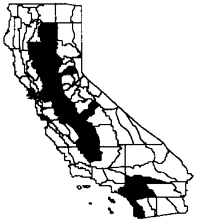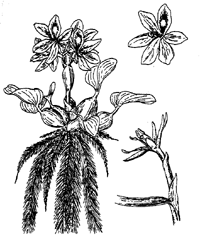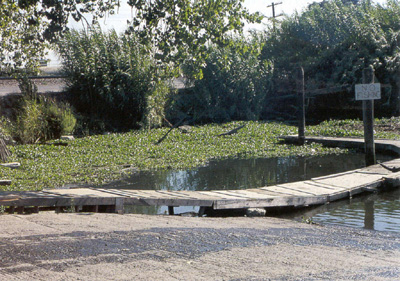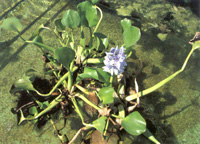|
Eichhornia crassipes
|
|
|
|
Scientific name
|
Eichhornia crassipes
|
|
Additional name information:
|
(C. Martius) Solms-Laubach
|
|
Common name
|
water hyacinth, common water hyacinth
|
|
Synonymous scientific names
|
Eichhornia speciosa, Piaropus crassipes, Pontederia crassipes
|
|
Closely related California natives
|
0
|
|
Closely related California non-natives:
|
0
|
|
Listed
|
CalEPPC List A-2,CDFA nl
|
|
By:
|
Kris Godfrey
|
|
Distribution
|
|
|
HOW DO I RECOGNIZE IT?
Distinctive features:
|
Water hyacinth (Eichhornia
crassipes) is a floating aquatic plant with bright green, waxy leaves and
attractive, violet flowers that have yellow stripes on the banner petals. These
plants tend to form mats on the water surface. Sometimes water hyacinth can be
found growing in muddy soils near the edge of an aquatic system. The leaves are
arranged in a rosette. The leaf stem usually is somewhat to completely swollen
and filled with spongy tissue and thus acts as a float. In plants anchored in
mud, the leaf stem tends not to be swollen. The blade of the leaf is oval to
round and usually much smaller than the leaf stem.
åÊ
|
|
Description:
|
| Pontederiaceae. Perennial, floating aquatic plant. Stems: Stout, erect; may be connected by stolons; may be greater than 12 in (30 cm) in length. Leaves: Blade is generally oval to round and usually not greater than 4 in (10 cm) in width; leaf stem is somewhat to completely swollen, filled with spongy parenchyma tissue, 1-1.5 in (2-3 cm) diameter, generally longer than the blade (McClintock 1993). Inflorescence: funnel-shaped flowers borne on 2-6 in (5-15 cm) spikes. |
|
Flowers: perianth varies from pale to deep
lavender to blue or white; banner petal has a diamond-shaped yellow-orange spot
surrounded by a wide pale purple border (Penfound and Earle 1948, McClintock
1993). Fruit: a capsule, usually surrounded by the remains of dried flowers; +/-
50 seeds per capsule; seeds longitudinally ribbed (Penfound and Earle 1948,
Hickman 1993).
åÊ
|
|
WHERE WOULD I FIND IT?
|
Water hyacinth can be found in both natural
and man-made freshwater systems (ponds, sloughs, rivers). It will not tolerate
brackish or saline water with salinity levels above 1.8 percent (Penfound and
Earle 1948). In California water hyacinth typically is found below 660 feet (200
m) elevation in the Central Valley, San Francisco Bay Area, and South Coast. The
Sacramento-San Joaquin Delta and several of the rivers drained by this delta are
heavily infested (Thomas and Anderson 1984).
åÊ
|
|
WHERE DID IT COME FROM AND HOW IS IT SPREAD?
|
Native to the Amazon River basin of tropical South America,
water hyacinth has now spread to all tropical and subtropical countries and is
universally regarded as one of the most serious of the worldÛªs weeds (Parsons
1992). It was introduced into the United States in 1884 as an ornamental plant
for water gardens. The plant quickly spread throughout the country, becoming a
major weed in southern states from Florida to California. By 1897 it had clogged
many waterways and was interfering with shipping (Parsons 1992). It was found in
California in 1904 (Thomas and Anderson 1984).
Water hyacinth spreads through fragmentation of established
plants and may resprout from rhizomes or germinate from seeds (Penfound and
Earle 1948). Dispersal also occurs by water-borne seeds and by seeds that stick
to the feet of birds. Migratory birds may be important in long-distance
dispersal (Parsons 1992).
The major means of dispersal, and the most difficult to control,
is active transport by people who, ignorant of its impacts, seek to propagate it
in other ponds and lakes. In Australia almost every new infestation has come
from deliberate planting or the disposal of surplus material from deliberate
planting. Humans also contribute to its spread in some areas by using the plant
as a packing material and as cushions in boats (Parsons 1992).
Water hyacinth has many functional properties, and expanded use
of the plant may contribute to its spread. For example, it is attracting
attention in the United States for use in sewage and industrial waste treatment.
A 0.5 ha lagoon of the plant can purify the daily sewage waste of 1,000 people.
It is being used in some countries to treat effluent from paper mills,
tanneries, and factories producing explosives, rubber, photographic chemicals,
and palm oil. It can remove heavy metals and pesticides from contaminated water
and is being considered as a means of removing radioactive contaminants from
nuclear power plant wastewater (Parsons 1992).
åÊ
|
|
WHAT PROBLEMS DOES IT CAUSE?
|
Water hyacinth can quickly dominate a waterway or aquatic system
because of rapid leaf production, fragmentation of daughter plants, and copious
seed production and germination. It degrades habitat for waterfowl by reducing
areas of open water used for resting, and when decomposing it makes water unfit
for drinking. It displaces native aquatic plants used for food or shelter by
other wildlife species.
Water hyacinth causes problems for humans by obstructing
navigable waterways, impeding drainage, fouling hydroelectric generators and
water pumps, and blocking irrigation channels. By 1975 nearly 700,000 hectares
of waterways in Louisiana alone were infested, and rivers were blocked for
distances of forty kilometers. Agricultural production in CaliforniaÛªs Central
Valley was threatened at one point because of an 80 percent reduction in the
efficiency of irrigation channels and pumping equipment. From one district
alone, 20,000 truckloads of the weed were removed from waterways in 1981-82. The
problem has diminished markedly in recent years as a result of control efforts
(Parsons 1992).
The protected water within mats of water hyacinth makes ideal
breeding sites for mosquitoes and other vectors, which, in tropical countries,
increases the danger of malaria, schistosomiasis, and other diseases (Parsons
1992).
Water hyacinth increases water losses from lakes and rivers
because of the plantÛªs high transpiration rate, calculated to be almost eight
times the evaporation rate of open water surfaces (Parsons 1992). It changes
water quality beneath the mats by lowering pH, dissolved oxygen, and light
levels, and increasing CO2 tension and turbidity (Penfound and Earle 1948;
Center and Spencer 1981). This affects the health of fish, while decaying plants
make water unfit for drinking by humans, livestock, and wildlife.
The weed is a major concern in other countries as well. It has
resulted in tremendous losses annually in fish and paddy rice production in
India. In the Sudan it had infested over 3,000 kilometers of rivers by 1979,
resulting in an estimated 10 percent loss in the normal flow of the Nile River
and costing more than $3 million per year in control efforts (Parsons
1992).
åÊ
|
|
HOW DOES IT GROW AND REPRODUCE?
|
Water hyacinth can reproduce either sexually or vegetatively. Flowering (i.e., sexual reproduction) occurs in mid-summer and early fall. The flower stalks bend back into the water once they are pollinated (it is thought to be self-pollinated) and release the seeds. Seeds sink to the bottom and can remain viable in sediments for several years.
Water hyacinth seeds require warm, shallow water and high light
intensity for germination. Submerged seedlings root in the substrate and then
form four or five linear leaves 0.2-0.6 in (5-15 mm) in length. The sixth and
later leaves contain large amounts of spongy parenchyma tissue, which adds
buoyancy to the seedlings. When seedlings are sufficiently buoyant, they break
off from the roots and float to the surface. Once on the surface, seedlings form
numerous fibrous and adventitious roots beneath the stem. The plants continue to
grow by adding leaves in a whorl-like fashion, with the oldest leaves on the
outside of the plant (Center and Spencer 1981). When daughter plants are of
sufficient size, they break off the parent plant.
Vegetative reproduction occurs from late spring through fall.
Parts of the stem may break off at the water surface to form independent plants
called daughter plants (Penfound and Earle 1948). These daughter plants are
capable of producing additional reproductive stem segments within weeks.
|
Water hyacinth
grows rapidly. Growth of more than one ton of dry matter per day per
hectare is not uncommon. One plant may be able to produce enough growth to
cover 600 square meters in one year. Infestations break up into ÛÏraftsÛ
that drift wherever the winds and currents take them, rapidly infesting
entire river systems (Parsons 1992).
|
(click on photos to view larger image)
|
|
|
HOW CAN I GET RID OF IT?
|
The best method of controlling water
hyacinth is to prevent it from being introduced into a freshwater system. This
can be done by educating the public about the problems that occur from disposal
of unwanted water garden or aquarium plants into freshwater systems or by not
properly cleaning boats, trailers, other water sports equipment, bait buckets,
or fishing equipment to remove all plant material before moving the equipment to
another freshwater system.
åÊ
|
|
Physical control:
|
Manual/mechanical methods: For small ponds
or lakes infested with water hyacinth, harvesting and removal of plant material
from the water can be attempted. Care must be taken to remove all plant
material, including small fragments. Harvesting and removal of plant material is
labor-intensive and expensive. A less expensive method of containing water
hyacinth is the use of floating barriers that can contain the weed in a small
area. Dredges, which drag plants onto river banks, are effective if the material
is allowed to dry and is then burned. These are costly efforts, and they have
been replaced in most areas by chemical control (Parsons 1992).
åÊ
|
|
Biological control:
|
Insects and fungi:
Biological control has been successful in many, but not all, areas. Three
insects and a fungus have been extensively studied and subsequently released by
the USDA to control water hyacinth. The insects include two weevils,
Neochetina eichhorniae Warner, and N. bruchi Hustache
(Coleoptera: Curculionidae), and a moth, Sameodes albiguttalis Warren
(Lepidoptera: Pyralidae). The fungus is Cercospora rodmanii
Conway (Fungi
Imperfecti: Moniliales), which was first found in Florida in 1976 (Conway
1976).
In the southern United
States the weevils have been most effective in reducing water hyacinth
populations (Center et al. 1989). In Florida the weevils combined with the
fungus have also produced good results. In California all three species of
insects have been released. However, only Neochetina eichhorniae
has established, and its impact on density of water
hyacinth is slight. The fungus is currently unavailable for use in
California.
Grazing: Most animals, except rabbits, do not readily eat the
plant, possibly because its leaves are 95 percent water and have a high tannin
content.
åÊ
|
|
Chemical control:
|
Water hyacinth can be controlled using
glyphosate as a foliar spray (formulated as Rodeoå¨) and copper complexes used
only as a foliar spray. Herbicide use is more highly regulated in aquatic
systems than in terrestrial systems. A current label for the herbicide must be
obtained to determine suitability for a given system and amount of active
ingredient to be applied. Both suitability and the amount of active ingredient
may change from one year, habitat type, and/or jurisdiction to another. Consult
your county agricultural agent or a certified herbicide applicator.
åÊ
|




